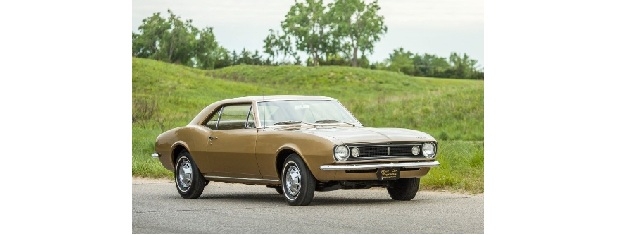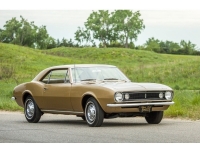Automobiles
The Chevrolet Camaro - Born 50 Years Ago This Week
9 Things about the First Camaro

Chevrolet Camaro (Source: Historic Vehicle Association)
Fifty years ago this week the first pilot prototype Camaro was built. To commemorate this golden anniversary the Historic Vehicle Association (HVA) uncovered these little known gems.
- 9. Born in Cincinnati
The first pilot prototype Camaro (No. 100001) was assembled on May 21, 1966 at the General Motors Assembly Plant, located in Norwood, Ohio, a few miles from Cincinnati. Why Cincinnati ? GM produced a large share of the subsequent production Camaros at the Norwood plant and used the construction of 49 pilot prototypes to develop the assembly line and equipment needed for high volume, serial production.
- 9. Born in Cincinnati
The first pilot prototype Camaro (No. 100001) was assembled on May 21, 1966 at the General Motors Assembly Plant, located in Norwood, Ohio, a few miles from Cincinnati. Why Cincinnati ? GM produced a large share of the subsequent production Camaros at the Norwood plant and used the construction of 49 pilot prototypes to develop the assembly line and equipment needed for high volume, serial production.
The Norwood plant was not going to be the only assembly line for Camaros, however, so the company also built three pilot prototypes at their Van Nuys, Los Angeles plant. The Norwood plant was not going to be the only assembly line for Camaros, however, so the company also built three pilot prototypes eight weeks later at their Van Nuys, Los Angeles plant.
- 8. Top Secret“”for Real
Ford spent years teasing the public with show cars and concepts that hinted at the anticipated Mustang. GM, by contrast, revealed nothing about the Camaro until the car's name announcement in June 1966 and formal Detroit launch in August 1966. Dealers had cars within a month. Boom.
- 8. Top Secret“”for Real
Ford spent years teasing the public with show cars and concepts that hinted at the anticipated Mustang. GM, by contrast, revealed nothing about the Camaro until the car's name announcement in June 1966 and formal Detroit launch in August 1966. Dealers had cars within a month. Boom.
- 7. How about Panther ?
The Camaro almost wasn't. GM brass considered dozens of names including 'GeMini,' Commander,' and 'Wildcat,' until finally settling on 'Panther.' The company then invested over $100,000 in Panther badges only to dramatically change course just a few weeks before the debut. "Camaro," which is a meaningless word, emerged as the dark horse winner.
The Camaro almost wasn't. GM brass considered dozens of names including 'GeMini,' Commander,' and 'Wildcat,' until finally settling on 'Panther.' The company then invested over $100,000 in Panther badges only to dramatically change course just a few weeks before the debut. "Camaro," which is a meaningless word, emerged as the dark horse winner.
- 6. Camaro vs. Mustang
The Mustang proved that GM's small and sporty Corvair wasn't the right recipe. So GM rushed development of the Camaro, birthing the car in 36 months, and nearly photocopying Ford's playbook. While the Camaro did not equal the Mustang's incredible sales success“”Ford sold over half a million Mustangs in 1965“”GM moved more than 400,000 Camaros in the first two years. But perhaps more importantly, the Camaro kicked of Detroit's greatest rivalry, pushing each to new heights
The Mustang proved that GM's small and sporty Corvair wasn't the right recipe. So GM rushed development of the Camaro, birthing the car in 36 months, and nearly photocopying Ford's playbook. While the Camaro did not equal the Mustang's incredible sales success“”Ford sold over half a million Mustangs in 1965“”GM moved more than 400,000 Camaros in the first two years. But perhaps more importantly, the Camaro kicked of Detroit's greatest rivalry, pushing each to new heights
- 5. A Golden Tradition
General Motors used a gold exterior and interior color scheme for its first prototypes and kept that tradition for the Camaro. And amazingly, that gold prototype Camaro (No. 100001) still exists.
- 4. Most Important New GM Model in 50 Years
The success of the Camaro not only represented a positive boost to General Motors' sales and profits, but also played a key role in the subsequent boom of the so-called 'muscle car' market. And GM was a powerhouse muscle car maker.
General Motors used a gold exterior and interior color scheme for its first prototypes and kept that tradition for the Camaro. And amazingly, that gold prototype Camaro (No. 100001) still exists.
- 4. Most Important New GM Model in 50 Years
The success of the Camaro not only represented a positive boost to General Motors' sales and profits, but also played a key role in the subsequent boom of the so-called 'muscle car' market. And GM was a powerhouse muscle car maker.
- 3. Camaro No. 100001 Will Enter the HVA's National Historic Vehicle Register
The first Camaro (No. 100001) is currently being exhaustively measured and documented by the HVA using the guidelines set by the Secretary of the Interior's Standards for Heritage Documentation and the Historic American Engineering Record (HAER). Once complete, the material will permanently reside in the Library of Congress, joining such iconic cars as the Shelby Cobra Daytona prototype, the first Meyers Manx dune buggy and one of the last surviving Futurliners. This is being done to preserve an important chapter in America's automotive heritage.
The first Camaro (No. 100001) is currently being exhaustively measured and documented by the HVA using the guidelines set by the Secretary of the Interior's Standards for Heritage Documentation and the Historic American Engineering Record (HAER). Once complete, the material will permanently reside in the Library of Congress, joining such iconic cars as the Shelby Cobra Daytona prototype, the first Meyers Manx dune buggy and one of the last surviving Futurliners. This is being done to preserve an important chapter in America's automotive heritage.
- 2. Third Most Popular Collector Car
With over one million collector car vehicles insured in the United States, Hagerty ranks the Camaro third in overall popularity. The most popular collector car is the Chevrolet Corvette followed by the Ford Mustang.
- 1. Coming to Detroit in August
A special HVA exhibition of the first Camaro (No. 100001) will be on display in Detroit to celebrate the 50th Anniversary of the launch in 1966. The exhibition will coincide with the annual Woodward Dream Cruise week (August 13-20). The first Camaro will be on public display in the HVA's glass cube that recently featured President Reagan's Willys Jeep on the National Mall in Washington, DC.
With over one million collector car vehicles insured in the United States, Hagerty ranks the Camaro third in overall popularity. The most popular collector car is the Chevrolet Corvette followed by the Ford Mustang.
- 1. Coming to Detroit in August
A special HVA exhibition of the first Camaro (No. 100001) will be on display in Detroit to celebrate the 50th Anniversary of the launch in 1966. The exhibition will coincide with the annual Woodward Dream Cruise week (August 13-20). The first Camaro will be on public display in the HVA's glass cube that recently featured President Reagan's Willys Jeep on the National Mall in Washington, DC.
The HVA is dedicated to preserving and sharing America's automotive heritage. In 2014, the HVA established the National Historic Vehicle Register. Working with the U.S. Dept. of the Interior, Heritage Documentation Programs and Library of Congress, their aim is to document historically significant automobiles in America's past.
Source : Historic Vehicle Association
Ruby BIRD
http://www.portfolio.uspa24.com/
Yasmina BEDDOU
http://www.yasmina-beddou.uspa24.com/
Source : Historic Vehicle Association
Ruby BIRD
http://www.portfolio.uspa24.com/
Yasmina BEDDOU
http://www.yasmina-beddou.uspa24.com/
Ruby Bird Yasmina Beddou First Camaro The Chevrolet Camaro Born 50 Years Ago First Pilot Prototype Historic Vehicle Association Born In Cincinnati General Motors Assembly Plant
Liability for this article lies with the author, who also holds the copyright. Editorial content from USPA may be quoted on other websites as long as the quote comprises no more than 5% of the entire text, is marked as such and the source is named (via hyperlink).






